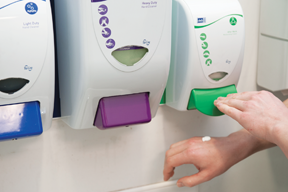The right products matter

By Isabelle Faivre
The skin is the single largest organ in the human body, consisting of 300 million skin cells and accounting for more than 10 percent of our body mass. Yet, this vital organ measures between .05 mm and 1.5 mm (as thin as a sheet of paper to as thick as a dime). However, many workers in an industrial setting overlook the importance of skin health and safety, considering it a trivial issue and a commodity buy. However, selecting and using the right product is vitally important to skin health and the overall health of a business. The United States Centers for Disease Control and Prevention (CDC) reports that occupational skin disorders, such as dermatitis, are the most common type of workplace illnesses, with estimated costs, including time away from work, reduced productivity and workers compensation claims, exceeding $1 billion annually.
Helping your customers understand the causes and costs associated with occupational skin disease will not only help with building the relationship, but will boost your bottom line, increasing sales of skin care products and positioning you as their go-to for future needs.
What is occupational dermatitis?
Occupational dermatitis is defined as an inflammation of the skin caused by working environments or contact with damaging substances. While dermatitis can affect most industrial occupations, the most prevalent areas include construction, cleaning, maintenance and wet work, where the skin is exposed to moisture and wet conditions for long periods of time. According to the National Institute for Occupational Safety and Health, one out of every four workers is exposed to some form of skin irritant in the workplace. Furthermore, the CDC estimates that up to 40 percent of workers will suffer from occupational dermatitis at some point in their working life.
Dermatitis symptoms include irritation, redness and swelling of the skin and it can easily spread if left untreated. In an industrial setting, many workers think cracked, dry skin is just a part of their daily job and never report the occupational injury to their company or get the proper treatment. For this very reason, skin care experts believe that work-related dermatitis is likely underreported and underestimated by as much as 400 percent.
 The cost of occupational dermatitis
The cost of occupational dermatitis
The U.S. Bureau of Labor Statistics (BLA) data shows that approximately 50 percent of all working time lost to industrial illness is due to dermatitis. If not treated quickly and effectively, more serious long-term problems may develop. BLA data also shows that 75 percent of patients with occupational dermatitis develop chronic skin disease. Additionally, a single case of occupational dermatitis can cost an employer approximately $3,500 in workers’ compensation claims. This vast issue can have a huge impact on your customers’ productivity, profitability and overall staff morale.
The right products matter
Educating yourself and your customers on occupational skin disease is only half the battle. The next and most significant step is prevention. Fortunately, dermatitis is far easier and less time consuming and costly to prevent, than to remedy. Proper prevention begins and ends with buying and using the proper hand hygiene products.
With a multitude of industrial hand cleaning solutions on the market, how do you separate the good from the bad? We have put together a few key tips for finding and distributing the best products.
- Check the ingredient list of a product. The use of solvents such as paraffin, thinners, petrol distillates and mineral spirit should never be used to clean the skin. They are likely to remove too much of the skin’s natural oils. Suggest a solvent-free or, at least, a low-solvent content hand cleanser.
- Always recommend the least aggressive cleanser for the working condition and strongly oppose the use of paint thinners, gasoline or acetone for cleaning skin.
- For situations that require a deeper clean, avoid products with coarse abrasives such as pumice or sand. Suggest products with natural scrubbing agents such as walnut shell or cornmeal, similar to Deb’s GrittyFOAM or Solopol Classic, instead.
- Look for USDA bio-certified and eco-accredited products, like Deb Natural Power Wash. These products are less harmful to the environment and safer for customers. But be aware of false “green” claims. One regulating organization claims as many as 95 percent of consumer products make some kind of false claim about their environmental friendliness. You can visit the accreditation website to view all products that are certified with the associated organization.
- All products should be located and dispensed from an area that can be easily accessed by all. Suggest the purchase of a wall-mounted dispenser to your customers. Tubes of products tend to get misplaced.
- Go beyond PPE. Personal protective equipment, such as gloves, is commonly used to protect workers’ hands from harsh chemicals, extreme environments or other irritants. However, moisture produced by our sweat glands can get trapped inside the glove, only contributing to the problem. The moisture build-up can cause severe skin irritation, even after removing the glove. Dermatologists recommend that protective pre-work barrier creams like Deb Universal Protect or Stokoderm Glove & Grip be used in combination with properly chosen gloves as a supplemental means of protection or alone if workers are not able to wear personal protective equipment.
- When it comes to pre-work barrier creams, recommend using only a small amount. Otherwise, the skin will become greasy, affecting workers’ ability to handle tools and most likely discourage workers from future use.
- Don’t forget the important last step. In addition to pre-work protection creams and hand cleansers, after-work restore products are another line of defense against occupational skin disease. Products like Stokolan Classic or Stokolan Intense condition the skin and replenish lost naturals oils. Most conditioning products sold contain about 90 percent water. A product containing 15 percent to 30 percent fats or oils is preferable.
Customers rely on you and your dedicated sales team to be experts in the field. To stay competitive, you must understand and fulfill their needs, supplying them with not only products, but solutions. Occupational skin care may not be in the forefront of their minds, but after evaluating the scope of the problem, it should be. With proper education and the appropriate skin care products, occupational dermatitis and the costs involved can be greatly reduced. With healthy and productive workers, any customer investment in a skin care solution flows directly back to their bottom line and also to yours.
 Isabelle Faivre is vice president of marketing at Deb Group, the world’s leading occupational skin care company. For more information on effective strategies for improving skin care in the workplace and preventing occupational dermatitis, please visit www.debgroup.com.
Isabelle Faivre is vice president of marketing at Deb Group, the world’s leading occupational skin care company. For more information on effective strategies for improving skin care in the workplace and preventing occupational dermatitis, please visit www.debgroup.com.
This article originally appeared in the Jan./Feb. 2015 issue of Industrial Supply magazine. Copyright 2015, Direct Business Media.












